
Protecting workers when using metalworking fluids
Published Jun 02, 2021
Exposure to metalworking fluids can cause irritation of the skin in the form of dermatitis, and lung diseases such as occupational asthma and occupational hypersensitivity pneumonitis. Following a period of research and the continuing high number of cases in relation to exposure to metalworking fluids (MWF), the HSE updated their guidance on the topic in February 2019, alongside their update on welding fumes. The HSE are currently carrying out inspections on premises where such activities take place to ensure the correct control measures are being implemented and employee exposure is being controlled.
What are the health risks?
Cancer:
In the past, the use of unrefined mineral oils led to skin cancer affecting the exposed skin, often hands and forearms. Also, oil-soaked clothing and oily rags kept in overalls caused cancer of the scrotum. Today, the use of highly refined oils and the substitution of cancer-causing chemicals in metalworking fluids, as well as changes in work practices and improved personal hygiene, have reduced the risk of cancer.
Absorption – skin:
A serious health concern associated with MWF are skin problems, most notably dermatitis. Each year, over 200 cases are reported that are associated with MWF, but it’s believed this figure is substantially underreported and there are far more cases in workplaces each year. Bare skin on the hands and forearms and the presence of cuts and grazes coming into contact with MWF when draining fluids, handling workpieces, changing tools, cleaning and maintenance operations all give opportunity for exposure. You should also consider that if appropriate splash guards are not in place then the face can also be exposed to MWF.
Whilst dermatitis is typically a disease that develops over time through repeated exposures, MWF have the ability to cause an immediate allergic reaction. To prevent this, employers should always have the appropriate control measures in place to protect their workers.
Inhalation – lungs:
A growing concern and a primary reason for the 2019 guidance update is the risk of occupational asthma and hypersensitivity pneumonitis – this is an inflammation of the lung tissue caused by an infection through breathing in MWF mists. There have been several large outbreaks of respiratory diseases related to the use of MWF in the UK in recent years, and as many as 3000 new cases each year across all industries of occupational asthma in UK workplaces.
An additional health risk is the use of wash fluids to clean machined components or clear lines in machines mid or post-process that can become highly contaminated with harmful bacteria. In addition to the risk of dermatitis or respiratory diseases, poorly managed sources of MWF have the potential to develop legionella bacteria, which ultimately can harm persons if inhaled again as mist and can cause Legionnaire’s disease. These sources and pipework should be monitored and controlled as part of your legionella management on site.
Ingestion – mouth:
If staff are allowed to eat or drink in work areas, do not wash their hands properly or have poor methods of removing gloves that can lead to cross contamination, it is possible that MWF can be ingested through the mouth when staff go for smoke or lunch breaks.
What precautions should you take?
The more that you know about the hazards associated with MWF the better you can introduce appropriate control measures to control the exposure to your staff. Controls will be specific to your workplace, and so it is your responsibility as an employer to carry out suitable and sufficient CoSHH assessments for the products and processes being used. There are, however, some general control measures that you can ensure are in place to support your workforce:
- Follow instructions and training given by your employer on safe systems of work when working with metalworking fluids.
- Use splash guards, where provided, to control splashing and misting.
- Minimise production of mist and vapour by controlling the volume and rate of delivery of the fluid to the cutting edge of the tool.
- Use any enclosures or ventilation provided to remove or control any mist or vapour produced.
- Allow a time delay before opening doors on machine enclosures to ensure that all mist and vapour have been removed by the ventilation.
- Report any damaged or defective splash guards, ventilation hoods or other control equipment.
- Open workroom doors and windows to improve natural ventilation.
- Don’t use compressed air to remove excess metalworking fluids from machined parts, plant or equipment.
What support can I get with managing MWF?
At SSG we have a range of consultancy and training services that can support you in the identification, management and control of risks associated with MWF in your daily operations. The management of MWF primarily falls under CoSHH, and so a good understanding of the CoSHH assessment process and associated regulations is essential. There are also several HSE resources and good practice guides available to support employers in adopting the most appropriate control measures to protect their workers, and a small selection have been included below:
- HSE metalworking guidance page – click here
- Good practice guide for handling and disposing of metalworking fluids – click here
- CoSHH essentials for machining with metalworking fluids: advice for managers – click here
- INDG365 Working safely with metalworking fluids: a guide for employees – click here
Source: David Wright